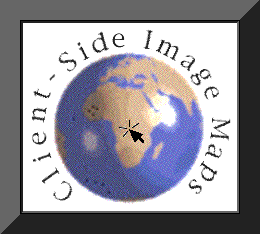

Now, you're probably wondering "What's so special about client-side image maps?". In the old days, before Netscape 2.0 was released, to implement an image map, your web page had to run a small program on the web page's server to translate the location of the click to something useful. This has the draw-back of requiring the server to perform extra work to simply convert a pair of coordinates into a location. This means the server has less time to dish out web pages to other people and you also have to wait for your browser to find out where to go next.
Now, what's a client-side image map? The type of image map described in the previous paragraph can be called a server-side image map, so it would be safe to conclude that a client-side image map means that your web client (a.k.a web browser) performs the dirty work of tranlating click locations.
If you're still not sure what this client and map stuff means, don't worry, it'll start to make sense once you play around with some image maps. In fact, you might even have fun!
Before you get started, make sure you are using Netscape version 2.0 or greater. If you don't have Netscape version 2.0 or greater yet, you can download it by clicking on the Netscape logo below.


...and that's it. You should now have a web page with a working
client-side image map.
http://www.cgocable.net/~cassidyb/cis500/session9/tutorial/tutorial.html
Image Map Design Process
The steps to develop a web page using client-side image maps are
fairly straight forward. Follow each of the hyper-links below to see a full
explanation of each step. Throughout this tutorial there will be things
to view or download, so you can build your very own image map page along
with this tutorial.
Step 1 - Create a new HTML document
Step 2 - Create or obtain an image to use as an image map
Step 3 - Determine coordinates surrounding "hot spots"
Step 4 - Put a MAP definition in your HTML document
Step 5 - Set up destination documents (if needed)
Where to go from here?
That's for you to decide. Try to be creative and replace simple
hypertext lists (like the steps above) with an image map. There are
many other uses for image maps, just let your imagination flow.

Bill Cassidy, November 4, 1998